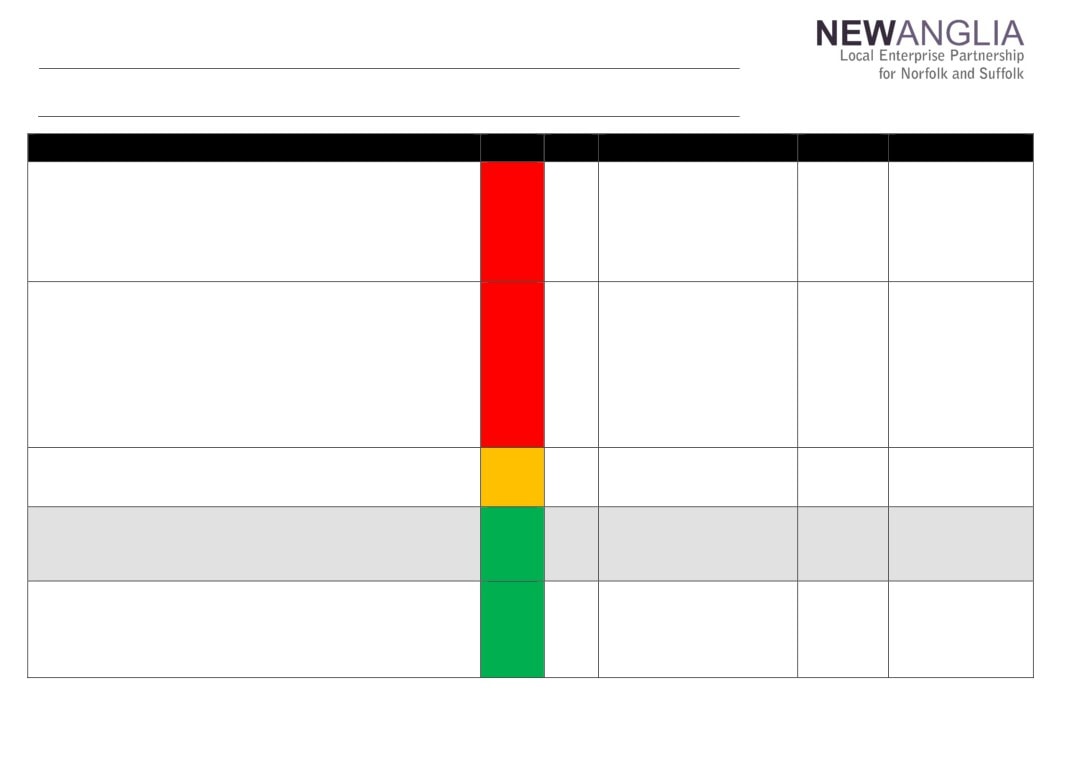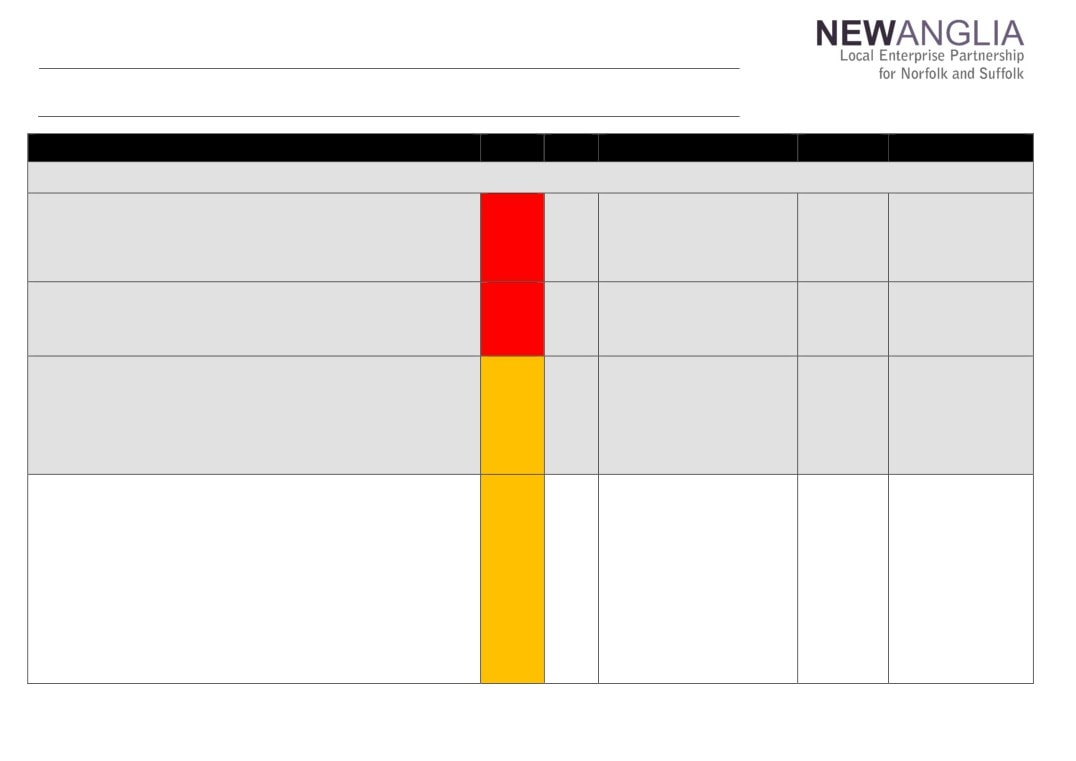New Anglia Local Enterprise Partnership Board Meeting
Wednesday 21st March 2018
10.00am to 12.30pm
The Jockey Club, 101 High St, Newmarket, Suffolk CB8 8JL
Agenda
No.
Item
Duration
1.
Welcome
20 mins
2.
Apologies
3.
Declarations of Interest
4.
Horse Racing Industry Presentation from Rachel Hood
5.
Actions / Minutes from the last meeting
Forward looking
30 mins
6.
Institute of Technology - Confidential
Update
Governance and delivery
100 mins
7.
2018/2019 Budget - Confidential
For approval
Capital Growth Programme Bid - Snetterton Heath including
8.
For approval
Confidential Appendices 2 and 3
9.
Growth Deal Funding Change Request - NATS Packages
For approval
10.
Growth Deal Funding Change Request - Cornhill
For approval
11.
Growing Places Fund - Atex Business Park - Confidential
For approval
12.
Scheme of Delegation
For approval
13.
Chief Executive’s report including PwC Implementation Plan
Update
14.
Finance Report including Confidential Appendices
Update
15.
Board Forward Plan
Update
16.
Any Other Business
Update
Date and time of next meeting: 18th April 2018. 10am-12.30pm
Venue: The Green Britain Centre, Turbine Way, Swaffham PE37 7HT
1
New Anglia Board Meeting Minutes (Unconfirmed)
21st February 2018
Present:
Cllr David Ellesmere (DE)
Ipswich Borough Council
Doug Field (DF)
East of England Coop
Cllr Cliff Jordan (CJ)
Norfolk County Council
Dominic Keen (DK)
High Growth Robotics
Colin Noble (CN)
Suffolk County Council
Steve Oliver (SO)
MLM Group
Cllr Andrew Proctor (AP)
Broadland District Council
Johnathan Reynolds (JR)
Nautilus
Prof David Richardson (DR)
UEA
Lindsey Rix (LR)
Aviva
Sandy Ruddock (SR)
Scarlett & Mustard
Jeanette Wheeler (JW)
Birketts
In Attendance:
Vivienne Gillespie (VG)
Suffolk New College (For Nikos Savvas)
Mike Stonard (MS)
Norwich City Council (For Alan Waters)
Vince Muspratt (VM)
Norfolk County Council (For Tracy Jessop)
Shan Lloyd (SL)
BEIS
Chris Dashper (CD)
New Anglia LEP
Chris Starkie (CS)
New Anglia LEP
Helen Wilton (HW)
New Anglia LEP
Sue Roper (SuR)
Suffolk County Council
Steven Greenwood (SG)
Cities and Local Growth Unit
Peter Sutton (PS)
Cities and Local Growth Unit
Jeannine Hoeckx
Government Internal Audit Agency
Patrick White (PW)
Metro Dynamics - For Items 6 and 7
Page 1 of 6
3
Actions from the meeting: (21.02.18)
Declarations of Interest - Ascertain whether regular Board substitutes need to complete
CS
Declaration of Interest Forms.
Economic Indicator Trajectories and Targets: To receive a paper on CO2 reductions for
CS/JR
consideration of inclusion in the economic strategy targets.
Brexit Analysis - To receive an action plan detailing the next steps, timescales and measures of
LiR
success
Governance Review - To receive a proposed scheme of delegation and decisions log at the
CS
March meeting
1
Welcome from the Chair
Doug Field (DF) welcomed everyone to the meeting and thanked Lindsey Rix for hosting. He welcomed
the attendees including Vivienne Gillespie, deputising for Nikos Savvas, Mike Stonard deputising for Alan
Waters and Vince Muspratt, deputising for Tracy Jessop.
Chris Starkie (CS) updated the meeting on the Annual Conversation and the resulting deep dives being
carried out on a number of underperforming LEPs. New Anglia has been identified as a high performing
LEP and will be used as a control deep dive over the next 3 days. DF then welcomed those carrying out
the deep dive namely Jeannine Hoeckx who was in attendance and Steven Greenwood and Peter
Sutton, who joined the meeting at 10.20.
2
Apologies
Apologies were received from:
Cllr Alan Waters
Cllr John Griffiths
Dr Nikos Savvas
Tim Whitley
Tracy Jessop
Lisa Roberts
3
Declarations of Interest
The board were reminded that declarations of interest are required as part of LEP scrutiny and must be
submitted to the LEP office at the earliest convenience.
Declarations relevant to this meeting: None
Mike Stonard (MS) questioned whether those who regularly attend Board meetings as substitutes needed
to complete the Declarations of interest form. CS agreed to investigate further and advise the Board.
4
Welcome from Aviva
LR welcomed attendees to the meeting and gave an overview of Aviva, its role as a large local
employer and its importance to the region.
5
Minutes of the last meeting 17th January 2018
Actions from last meeting updated as follows:
Capital Growth Programme Projects - Identify whether other LEPS have received requests
CD
for investment in flood defence schemes. Investigations are ongoing.
Chief Executive’s Report
CS
For CS to produce a paper on the impact of GCGP changes - complete
Andrew Proctor (AP) queried whether the incorrect scoring on the Capital Growth Fund paper
presented at the last board had impacted on the decisions made about the bids. CS confirmed
that that decisions were based on the correct scoring.
6
Brexit Analysis
CS took the majority of the paper as read and provided background information on the Brexit
analysis carried out by Metro Dynamics.
Patrick White (PW) from Metro Dynamics updated the meeting on the background to the
research and the approach taken which aimed to link the analysis to the Economic Strategy.
The approach reviewed key sectors and then targeted individual companies to assess the
Page 2 of 6
4
impacts of Brexit specifically focussing on the impacts on trade, regulations, workforce and
funding.
The impact on the workforce was specifically identified as particular issue for this region given
the reliance on seasonal working and the issues already faced by companies in recruiting staff
with appropriate skills.
It was also noted that a replacement for current EU funding will be required however the details
of how this will be delivered remain unclear.
DF advised that the main report contained an initial action plan which will be progressed and
developed together with actions and targets. Timescales and measures of success will be
brought back to the Board in April or May.
David Ellesmere (DE) noted that companies employ staff elsewhere in the EU and the fall in
the value of the pound has already impacted upon the cost of employing them,
Jeanette Wheeler (JW) stated that companies were already struggling to recruit workers from
the EU and the LEP should focus on what can be done to assist in recruitment as all vacancies
will not be filled from within the UK.
Colin Noble (CN) felt that the LEP could have an important role post Brexit as it is a non-
political body which can have a key role in bringing together individuals and organisations
across the political lines. He also identified the skills shortage as the main issue and felt that
the LEP can lead on this point.
David Richardson (DR) agreed that the skills shortage would be significant and felt that the
LEP could be leading on co-delivery of programmes which would help to address this. He
requested that work start immediately to identify the skills gaps and investigate how they can
be addressed rather than leaving the work until Brexit has actually happened.
The meeting discussed how the Brexit research tied in with the Economic Strategy.
Shan Lloyd (SL) updated the meeting on Government work on the replacement of EU funding
advising that LEPs would play a key role in defining requirements.
The Board agreed:
To note the content of the report
To support the recommendations in the report
To receive an action plan detailing the next steps, timescales and measures of success
LiR
7
Economic Indicator Trajectories and Targets
CS took the majority of the paper as read and updated the meeting on the process followed to
build the trajectories and targets.
Dominic Keen (DK) queried whether economic fluctuations would be accounted for in the
projections. CS confirmed that progress against the targets was unlikely to be smooth but the
trajectory took this into account.
LR noted that having up to date data was key to ensuring that the projections were as accurate
as possible and also asked whether any qualitative measures were place. CS confirmed that
these would be included and proposed surveying businesses as an example of how these
could be gaged. LR proposed using a set of sample businesses who would participate in a
roundtable on a regular basis in order to monitor opinions.
Johnathan Reynolds (JR) proposed using sector groups and CS suggested contacting those
businesses which had received LEP funding to obtain views.
Vivienne Gillespie (VG) asked whether the skills targets could be broken down further. PW
confirmed that sub-metrics existed which would be recorded and reported back to the Skills
Board.
Page 3 of 6
5
The meeting discussed the role that the LEP should play in housing development given that the
LEP can drive provide infrastructure and help businesses in order to boost the demand for
housing but is not directly responsible for the provision of homes.
JR noted that there were no targets on CO2 emissions which were identified as key in the
Pathfinder project and recommended that this be included. It was agreed that a paper would
be submitted to a future Board meeting for consideration.
The Board agreed:
To note the contents of the report
Agree the methodologies that have been developed to set the targets for each of the
indicators up to 2021.
Agree the approach to monitoring and reporting on the indicators to the Board.
JR/CS
To receive a paper on CO2 reductions for consideration of inclusion in the economic
strategy targets.
PW left the meeting.
8
Governance Review
DF noted that, in order for the LEP to remain compliant, all Terms of Reference needed to be
published on the web site by 28th February and suggested that they be agreed by the Board
before going to each individual committee for approval. Part of each committee’s work
programme would be an annual review of its terms of reference to ensure its appropriateness.
CS updated the meeting on the background to the review and on work carried out to date. CS
thanked those Board members who had volunteered to sit on the various committees and
reviewed the high level details of the groups. He also confirmed that work was continuing on
the Scheme of Delegation and the Decision Log which would be brought to the March Board.
Chris Dashper (CD) outlined the Terms of Reference for the Investment Appraisal Committee
explaining its link to the Growing Business Fund Panel. Changes suggested at the recent
committee meeting would be incorporated into Terms of Reference.
It was noted that the Terms of Reference needed to include details of the committee
substitution policy.
DE proposed using the same approach to substitution as the main Board. This was agreed.
JW noted that the duration of appointment to each Board should be included.
The Board agreed:
To note the content of the report.
To agree the Terms of Reference for each of the Committees and Board subject to the
above changes.
To confirm the appointment of members to the new committees within the new
structure.
CS
To receive a proposed scheme of delegation and decisions log at the March meeting
9
24 Month Operational Plan Review
CS took majority of the paper as read and those areas where improvement had been made.
CJ asked whether sustaining businesses should be included as future aim as well as growing
the local economy. CS advised that this paper was a review of the previous plan which had
focussed on growth and agreed that this was included in future objectives as part of the
Economic Strategy. It was noted that the Board had agreed not to intervene in struggling
businesses but should support those existing ones which wish to evolve and expand.
JR queried the current status of the Oil & Gas Taskforce. CS advised that this was still
operational and he would be happy for JR to be involved in the future.
Page 4 of 6
6
The Board agreed:
To note the content of the report and the progress made against the 24 month
Operational Plan
10
New Anglia LEP ERDF Bid
CD took the majority of the paper as read and updated the meeting on the issues encountered
during the approval process for the last bid.
The Board was advised that, should the approval be delayed then there is a risk that there will
not be funding available for the Small Grants Scheme and Growth Hub after 31st August 2018
when current funding expires.
CD proposed that the Growth Hub and Small Grant Scheme continue in their current form until
the end of October 2018 to allow for possible delays and reduce the risk of the Programme
being disrupted. This would be achieved by using BEIS Growth Hub funding and Growing
Business Fund funding and would be recouped when ERDF funding was approved. In the
event that a decision on funding from MHCLG is still pending by September, the LEP Executive
would present a paper on future options to September’s board meeting.
The Board agreed:
To note the content of the paper.
To support the submission of a request for £7.4m of ERDF funding
To agree to the allocation of £150,000 of BEIS funding and £200,000 of the Growing
Business Fund to continue activity, should ERDF approval be delayed beyond August
2018.
11
Sub-National Transport Forum
CS took the majority of the paper as read and updated the meeting on the background to the
sub-national transport bodies and progress of the various bodies created to date.
A meeting was held in December 2017 which agreed to establish a sub-national transport
forum to be known as Transport East.
Steve Oliver (SO) asked how the LEP Transport Strategy was linked to this. CS advised that
the LEP would have its own strategy which will be presented at the May Board. Individual
counties or towns could also have strategies and this forum would pull together the various
strategies at a regional level.
The Board agreed:
To note the content of the report.
To agree to be a full member of Transport East
For DK to be a New Anglia LEP representative on Transport East
12
Chief Executive’s report including PwC and Mary Ney Review Implementation Plan
DF advised that a COO had been appointed with view to starting early in the summer. DF
thanked all those involved in the recruitment process.
CS took the majority of the paper as read and provided an update on the following items:
Growth Deal - CS reviewed the delivery of the Growth Plan detailing changes in spending from
last month.
Capital Growth Programme - CS advised that CEFAS & Bacton had been advised of the
decision. Deferred projects will be brought back to the Board meetings together for future
consideration.
Mary Ney Review - CS reviewed progress against the implementation plan.
The meeting was advised that the assurance framework needed to be updated in the light of
the changes agreed at this Board Meeting. This will be updated by the LEP team and added to
the web site by 28th February.
Page 5 of 6
7
JW asked whether requests for funding made to the Growing Business Fund would be added
to the web site. CS confirmed that only details of approved requests would be added as this
involved the spending of public funds. Those declined would not be included
The Board agreed:
To note the content of the report
13
Finance Report
CS took the majority of the papers as read and asked for questions from the Board.
It was noted that the cost of the Opportunity Area Director & her assistant were not included in
the budgeted costs but neither was the associated income so the net effect was nil.
The Budget will be presented to the March Board
The Board agreed:
To note the content of the report.
14
Any Other Business
DF advised that the Board Forward Plan would be a standing item at future meetings.
DF asked Board members whether they would prefer to receive appendices to Board papers as
a separate pack or as part of main paper. Board members agreed that they wished to continue
to receive them as part of the main pack.
Next meeting:
Date and time of next meeting: 21st March, 2018. 10am-12.30pm
Venue: The Jockey Club, Newmarket, Suffolk
Page 6 of 6
8
Actions from New Anglia LEP Board Meetings
Date
Item
Action
Update
Actioned By
Status
21/02/2018
Declarations of Interest
Ascertain whether regular Board substitutes need to complete
Declarations will be required. Charley Purves will
CS
On-Going
Declaration of Interest Forms.
contact Board substitutes to arrange completion
21/02/2018
Economic Indicator
To receive a paper on CO2 reductions for
CS and JR liaising
CS/JR
On-Going
Trajectories and Targets:
consideration of inclusion in the economic strategy targets
21/02/2018
Brexit Analysis
To receive an action plan detailing the next steps, timescales and measures of
Draft action plan is being produced
LiR
On-Going
success
21/02/2018
Governance Review
Governance Review - To receive a proposed scheme of delegation and decisions
Scheme of Delegation presented at March Board
CS
On-Going
log at the March meeting
meeting
17/01/2018
Capital Growth Programme
Identify whether other LEPS have received requests for investment in flood
Verbal update to be provided at March Board
CD
Complete
Projects
defence schemes.
meeting
22/11/2017
Business Performance
To receive a proposal on the Eastern Agi-Tech initiative by email.
On hold pending clarification on the situation at
CS
On Hold
Reports
GCGP
9
New Anglia Local Enterprise Partnership Board
Wednesday 21st March 2018
Agenda Item 8
Capital Growth Programme Bid: Snetterton Heath Employment Area
Author: Chris Dashper
Summary
The Capital Growth Programme call for projects was launched immediately following the
October 2017 LEP Board meeting.
Under the call, £9m of grant funding from the Growth Deal was made available to support
projects that help to deliver the new Economic Strategy.
At the January meeting of the LEP Board, the board agreed to support two of the 29 project
applications received. The remainder of the applications were either deferred pending further
information or rejected. The updated table of deferred projects is included for reference as a
confidential appendix to this paper.
One of the deferred projects, Snetterton Heath Employment Area Electricity Upgrade Scheme
has now supplied the required additional information necessary for a decision to be made on
the financial support for the project.
Appendices 2 and 3 are deemed confidential because they contain commercially sensitive
information.
Recommendation
The Board are asked to:
Approve the award of Capital Growth Programme grant funding in the amount of
£2.65m to the Snetterton Heath Employment Area Electricity Upgrade Scheme,
following recommendation by the Investment Appraisal Committee.
Background
The Capital Growth Programme Call for Projects was launched after the October LEP Board
meeting, with £9m from the Growth Deal made available to support projects that helped to the
deliver the new Economic Strategy.
A total of 29 project Expressions of Interest were received as a result of the call, with sectors
including infrastructure, transport, employment projects, skills and cultural themed projects.
At the January 2018 LEP Board 2 projects, Bacton to Walcott Coastal Management Scheme
and CEFAS Research Centre were approved, allocating £2.48m of the £9m round. A further 20
1
25
of the project applications were deferred, pending further information. One of the deferred
projects was the Snetterton Heath Employment Area Electricity Upgrade scheme.
Since the January LEP Board meeting, the applicant for the Snetterton project, Breckland
District Council, has provided significant additional information on the delivery of the Snetterton
Heath Employment Area project and has also secured planning permission for the electricity
substation, one of the principle outstanding requirements necessary to allow approval of the
project.
Key issues
The Site
Snetterton Heath is the one of the largest of the A11 employment sites and one of the most visible
from the A11, five miles west of Attleborough and located in the Breckland District Council area.
It is an established location, with most of the spine infrastructure already provided including grade
separated A11 access. The Snetterton motor racing circuit, an internationally recognised venue,
forms part of the site and provides a potential basis for further employment. The only
infrastructure issue restricting the growth of site is the electricity constraints, an upgrade of the
supply being necessary to encourage further development.
Funding
Breckland District Council has applied to New Anglia LEP for a Capital Growth Programme grant
of
£2.65m towards the cost of a £3.5m scheme to upgrade the electricity supply to the
employment land. The costs of the project include a new substation to be located within the
boundary of the nearby Biomass Powerstation and new cabling to various parts of the
employment area. The balance of funding required will come from a grant from the Norfolk
Business Rates Pool.
Project proposal
The project proposal is to construct a new substation at the biomass plant to convert 33kv to 11
kv and link to the existing UKPN network. 11kv cable will then be run to the edge of each
landholding but no further. It will be the landowner’s responsibility to distribute the power
thereafter to individual parcels. Occupiers will also need to provide their own onsite substations
to step down the 11kv supply. Breckland proposes to fund the whole cost upfront so that
individual users can connect, as and when they arrive.
Consents
Heads of terms have been agreed for the siting of the substation. The majority of the cable runs
are along public highways and Norfolk County Council has confirmed that these can be
accessed without difficulty. There is no need to cross any other land not owned by the local
landowners. With planning permission now in place, this means there are no major constraints
to the delivery of the project.
State Aid
State Aid is often an issue for projects involving the supply of utilities. New Anglia LEP has
commissioned an independent legal report on the State Aid issues facing this project. The legal
advice confirms that in this circumstance, the aid is a permissible subsidy to UKPN to extend its
network, to the boundary of each site, to which the public has the right to connect. The effect of
the subsidy is to enable the serviced land to be offered at market price rather than at above
market price and does not give it a competitive advantage over other sites on the A11.
Ultimately the site would not be viable if the full cost of connection had to be met. An alternative
loan arrangement would not work in this circumstance.
2
26
Timescale
Breckland District Council are intending to start work almost immediately after approval of the
grant request. This ensures that the price quoted by UKPN remains viable. Cabinet approval of
the grant will be required and this has been scheduled for discussion in early April 2018.
Project history
New Anglia LEP has been supportive of the concept of improving the electricity supply at
Snetterton, this being a well-known local issue for some time. A previous attempt to address
this situation, with a confirmed grant offer from the Growth Deal could not ultimately be
delivered due to the costs involved and complex access rights including passing under the
railway line. The grant offer had to be withdrawn, the funding recycled back into the Growth
Deal and therefore forming part of the funding for the current Call for Projects.
The current version of the project is a much improved, comprehensive arrangement,
considerably more deliverable than before and fully State Aid compliant.
Financial implications
Approval of the project would bring the total formal allocation under the £9m call to £5.13m,
including the £2.48m allocated at the January 2018 Board meeting.
This would leave £3.87m to be allocated to the remaining deferred projects, subject to
additional information and appraisal. A further review paper on these projects is scheduled for
the May 2018 Board meeting.
A further £23m would then remain for a future call to be held in the summer/autumn. This could
support some of the deferred projects.
Link to the economic strategy
New Anglia LEP has previously invested in infrastructure including the A11 corridor and has
supported other successful large-scale employment sites with direct and indirect infrastructure
investment, including the 16 Enterprise Zone sites across Norfolk and Suffolk. Rarely viable in
conventional investment terms, this type of site often requires a public intervention to allow
progress to be made towards achieving growth, appropriate outputs and addressing issues such
as productivity.
The Cambridge-Norwich Tech Corridor and its developable employment areas including
Snetterton Heath are key aspects of the new Economic Strategy.
Recommendation
The Board are asked to:
Approve the award of Capital Growth Programme grant funding in the amount of £2.65m to the
Snetterton Heath Employment Area Electricity Upgrade Scheme, following recommendation by
the Investment Appraisal Committee.
Appendix 1: Appraisal process
Appendix 2: Confidential - consultants appraisal
Appendix 3: Confidential - deferred projects table
3
27
Appendix 1: Appraisal Process
Hewdon Consulting have been engaged to complete the initial appraisal of the project
applications received during the Call for Projects launched in October 2017.
All projects have been appraised in accordance with HM Treasury Green Book principles of
viability, value for money, achievability, affordability and need.
Following the receipt of additional supporting information, the Snetterton Heath Employment
Area project has been reappraised by Hewdon Consulting and re-scored in line with the October
2017 Call for Projects key criteria:
Capital Growth Programme Core outputs
Connectivity- investing in essential projects and assets that improve the infrastructure
and which create a modern, mobile, accessible future-proof digital connected economy.
Unlocking Growth- investing in infrastructure that unlocks or protects housing or
commercial developments in our key growth locations.
Investing in skills- investing in projects that deliver the higher level skills needed to drive
growth across our economy with a particular emphasis on our ‘innovation’ and ‘enabling’
sectors,
Key project assessment criteria
Whether the need for the project has been clearly demonstrated
Evidence of option appraisal and business case
How well the project meets the priorities of the Economic Strategy
How well the project fits with local and sub-regional plans and priorities
Potential for alternative funding, partnering and joint schemes
Estimated costs with level of detail to reflect the current stage of the project
Potential of the project to contribute to economic growth
Potential of the project to achieve payback
How likely the project is to be successful
How risks will be managed and mitigated
Economic outputs and impacts created by the project
How the benefits of the project will be sustained after LEP funding finished
Appraisal techniques used in the assessment of projects:
Justification of local economic need
Evidence of failure in commercial markets
Viability gaps for development of sites
Opportunity to accelerate delivery of development
State Aid
Strategic Prioritisation Framework
Projects have also been assessed against the LEPs own Prioritisation Framework,
which
includes the following key assessment criteria
Strategic Fit.
Consideration of whether the aim of the project is referenced in the Economic Strategy.
Also consideration of national economic development policy priorities, particularly those
in the Autumn Budget 2017 and the Industrial Strategy White Paper.
4
28
Deliverability
The main criterion was whether the project was sufficiently well advanced to draw down
LEP funding in 2018/19 and to complete by 2020/21 as the Call required. Key indicators
of deliverability included:
o Planning consent and land acquisition in place
o Other funding being committed
o A well-developed business case
Additionality
Projects should be able to demonstrate the addition of measurable direct outputs
corresponding to those in the Economic Strategy - such as jobs, houses, or Gross
Value Added (GVA) increase.
Economic Impact and VfM.
Ideally the outputs should be converted to a monetary value such as GVA and
compared with the cost to obtain the Net Present Value of the intervention. The
exception is transport projects for which a Benefit: Cost Ratio (BCR) is used.
5
29
New Anglia Local Enterprise Partnership Board
Wednesday 21st March 2018
Agenda Item 9
Growth Deal: Norwich Area Transportation Strategy (NATS)
Author: Chris Dashper, Jonathan Rudd
Summary and Recommendation
The LEP Board is requested to approve;
1. Transfer of £350,000 from the NATS A11 Corridor Package to the NATS City Centre Package
to balance out an underspend on one scheme (Daniels Road Junction) and overspend on
another (Guardian Road Junction).
2. Inclusion of a new scheme (Plumstead Road Roundabout) in the NATS City Centre Package to
replace a £400,000 scheme which is no longer deliverable (Salhouse Road Bus Rapid Transit
Scheme).
Background
Prior to the Growth Deal capital programme, the Department of Transport delegated responsibility
for allocating funding for capital transport projects to the Norfolk and Suffolk Local Transport Body
(LTB), an unincorporated entity. The LTB was subsequently subsumed into the LEP as a sub-
committee of the LEP Board and the LEP is responsible for managing the LTB capital programme.
The LTB operates a two-stage approval process which incorporates DfT requirements; an initial
assessment as part of the appraisal on new projects prior to Growth Deal Programme entry and a
further approval of constituent schemes on completion of the design stage involving a
proportionate Business Case.
The Norwich Area Transportation Strategy (NATS) is a Growth Deal project, approved by the LEP
board in 2015. It was originally promoted as a city-wide collection of schemes, but at the request
of government it was divided into the following two packages:
NATS City Centre Package (£7M) - principally to improve connectivity and accessibility within
the core retail and business district by removing through traffic from the city centre, but
retaining access to car parks, businesses and other premises. The package comprises of:
o Phase I; Chapelfield North scheme (pre-Growth Deal),
o Phase II (£2M); Golden Ball Street, Westlegate, All Saints Green, Ber Street and
Finkelgate
o Guardian Rd Junction (£1.55M); with A1074 Dereham & A140 Sweetbriar.
o Roundhouse Way Bus Interchange (£0.45M); Northwest of A11 junction.
o Phase III (£2.6M); Prince of Wales Road, Rose Lane and Agricultural Hall Plain.
o Salhouse Road Bus Rapid Transit (£0.4M).
1
35
NATS A11 Corridor Package (£4.175M) - focussed on the A11 corridor, to connect Norwich
city centre to growth areas in the south west including at the Norwich Research Park,
University and Hospital cluster, Cringleford, Wymondham and Hethersett:
o Part 1 (£2.175m);
UEA Bus/Transport Interchange, major upgrade,
Cycle link extension from Hethersett to Wymondham (off-carriageway),
A11 North slip road - Cringleford cycle track,
Eaton Centre to Newmarket Rd south slip Rd cycle facilities,
Toucan crossing on Newmarket Rd between poplar Ave & Unthank Rd.
o Part 2 (£2m); Junction improvement at A11 (Daniels Rd) & Outer Ring (Newmarket &
Mile End Roads).
Key Issues
1. Transfer of £350,000 between NATS Packages.
Introduction. On 23 Feb 18, the Local Transport body was asked to support a request to
reallocate £350,000 funds between the two NATS packages for the following reason:
Delivery of the Guardian Road junction improvement, part of the NATS City Centre Package,
will likely cost £700,000 more than the initial forecast of £1.55M.
Conversely, the cost of delivering the Daniels Road scheme within the NATS A11 Package is
estimated to be £350,000 below the initial forecast of £2M.
NCC raised the likely overspend on the Guardian Road junction back in October 2017, and the
possibility of covering the cost through virement from the NATS A11 was discussed. However,
planning for the Daniels Road scheme was not mature enough to present to the LTB or accurately
predict the saving. Consequently, NCC submitted an Expression of Interest to the November 2017
Call for Projects. This was rejected, since it is a standard condition that the total funding amount
set out in our grant agreements is the maximum allocated to deliver the Project, irrespective of any
cost increase, and there is no commitment to any uplift in the level of funding offered.
Notwithstanding this, in their feedback the LEP reiterated the possibility of covering the cost
overrun from the likely underspend in the NATS A11 package and stated that “the LEP Board
would be happy to receive a formal proposal to this effect via the Local Transport Body”. The
formal proposal was submitted to the LTB on 23 Feb 18, who recommended to approve the
transfer of £350,000 from the NATS A11 Corridor Package to the NATS City Centre Package.
Delivery
Guardian Road Junction. Provision of a new enlarged roundabout in place of the existing
roundabout, controlled pedestrian (toucan) crossings, reduction in the length of an existing bus
lane, new 30mph limits and altered segregated footway/cycleways.
Daniels Road Junction. Involves provision of dedicated turn lanes on selected arms of the
roundabout and reconfiguration of traffic lights and toucan crossings at adjacent junctions.
Funding. The saving from Daniels Road junction to be reallocated to the Guardian Road junction
to make up half of the increased cost, with NCC to meet the remaining £350,000, as follows:
Guardian Road Scheme Delivery timetable
Funding Source
15/16
16/17
17/18
18/19
Total
Growth Deal
£50,000
£1,451,000
£499,000
£1,900,000
NCC
£350,000
£350,000
Totals
£50,000
£1,801,000
£499,000
£2,250,000
2
36
Link to Economic Strategy
Guardian Road Junction. This scheme will improve connectivity and access within Norwich;
reduce congestion and journey times for businesses and commuters, improve bus reliability
and conditions for pedestrians and cyclists, and bring forward growth.
Daniels Road Junction. This aims to reduce delays experienced by bus passengers and
general traffic on Newmarket Road (A11) and ensure the ring road remains sufficiently free
flowing. This will benefit all modes of transport on this key transport corridor linking the city
centre with the radial routes to the south-west of Norwich where growth is planned at housing
and employment sites in Cringleford, Hethersett and Wymondham, as well as further afield at
Thetford.
2. Plumstead Road Roundabout.
Introduction. This is a new scheme under the pre-agreed NATS City Centre Package. It is
proposed to replace the Salhouse Road Bus Rapid Transit (BRT) scheme that formed part of the
original LEP Board approval. The BRT scheme is currently undeliverable due to both insufficient
demand and support from the bus operators.
Delivery. The scheme includes the redesign of a 3-arm offline roundabout, designed as part of
initial planning by property developers Lothbury, to incorporate a 4th arm and spur onto Broadland
District Council land. Planning permission has been granted for this new roundabout junction and
an agreement has been drafted with Lothbury to share the costs of developing and building the
junction. This will enable Lothbury to deliver the permitted 600 homes to the south of Plumstead
Road and provide access to a parcel of land in the ownership of Broadland District Council which
could be developed for a further 35 houses.
Funding. Growth Deal Funding remains consistent with the approved allocation of which £400k of
Local Growth Fund has been earmarked. The full £1M cost of the scheme will be met as follows:
Plumstead Road Scheme Delivery timetable
Funding Source
15/16
16/17
17/18
18/19
Total
Growth Deal
£10,000
£189,000
£201,000
£400,000
Developer
£400,000
£400,000
Local Authority/Other
£200,000
£200,000
Totals
£10,000
£189,000
£201,000
£600,000
£1,000,000
Link to Economic Strategy. This roundabout is aligned with the new Economic Strategy by
accessing land for two new housing developments. The new junction forms part of a strategic
growth area to the North East of Norwich identified in Broadland District Council’s Growth Triangle
Area Action Plan (GTAAP). The GTAAP was adopted in July 2016 and allocates sites within the
growth area for delivery of 7,000 houses by 2026.
Approval is sought for this scheme since the purpose falls outside of that approved for the whole
package; connectivity and accessibility within the core retail and business district. The formal
proposal was submitted to the LTB on 23 Feb 18, who recommended to approve this scheme
within the package and use of £400,000 of Growth Deal funds previously allocated to the Salhouse
Road Bus Rapid Transit scheme.
Summary and Recommendation
The LEP Board is requested to approve;
1.
Transfer of £350,000 from NATS A11 Corridor Package to the NATS City Centre Package.
2.
Inclusion of the Plumstead Road roundabout scheme into the NATS City Centre Package
and use of £400,000 of previously allocated funds.
3
37
New Anglia Local Enterprise Partnership Board
21st March 2018
Agenda Item 10
Growth Deal: Request for Additional Funding for the Cornhill Project, Ipswich
Author: Chris Starkie/Cathy Frost
Summary
To enable the successful completion of the Cornhill Regeneration Scheme in Ipswich, an
additional £50K is requested from New Anglia LEP to cover a slight shortfall in funding as a result
of exceptional circumstances. This project is a major town centre enhancement scheme
supported financially by Ipswich Borough Council, Suffolk County Council, New Anglia LEP and
Ipswich Central.
It is one of the main objectives of the Ipswich Vision and is supported by the seven main
stakeholders of the project (New Anglia LEP, IBC, SCC, UOS, Suffolk Chamber in Greater
Ipswich, Ipswich Central and Sandy Martin MP).
This contribution, a small proportion of the overall cost, will leverage match funding of £350k
already offered by other partner organisations. Without this additional money the project will be
unable to reach a satisfactory conclusion and compromises will have to be made to the design,
detrimentally affecting the original brief and impact for the town.
Recommendation
The Board is asked to agree the provision of an additional £50k to cover the shortfall in the
funding as a result of exceptional circumstances.
Background
The Cornhill Regeneration Project will provide a high-quality design and revitalisation to the
Cornhill central square in order to solidify its status as the main activity hub in the town centre
and is recognised as one of the main priorities for the Ipswich Vision.
It will enable the Cornhill to become a flexible and unique space. Local contractor Brooks and
Wood started on site on 29th January 2018, with a target completion date of 30th October 2018.
There will be a phased approach to the delivery of the project in order to minimise as far as is
possible the disruption to the town centre and those businesses trading in and around the area.
The Ipswich Market has already been relocated to Princes and Queen Street. The project will
comprise of the following elements
Levelling and repaving of the Cornhill square
Centrally located water feature incorporating water jets which can be turned off
Four sculptural archways approximately 4.5m high-public art element
1
39
Series of benches, new bins, lighting element and 5 new trees.
There is evidence that during the development and promotional phase of the project, there has
been significant interest from the business community and renewed confidence and investment
in the town centre.
It will act as a hub for creative events, scoping is now being undertaken by IBC to ensure a varied
number of events are programmed. It will also showcase the heritage and architecture on the
square itself and the wider offer of the town and waterfront. This will in part be achieved through
the storytelling on the 4 arches, public engagement has already been sought to help identify the
important stories. This activity will have a positive impact on the visitor economy, helping to attract
new visitors to the area and boosting retail trade and local services.
The LEP is currently providing £1.6m of the total £3.2m of the scheme, with significant
contributions coming from Ipswich Borough Council and Suffolk County Council.
Key considerations
Since the budget for the scheme was agreed, costs have risen. This is chiefly because the public
consultation led to changes in the overall design which have led to different features and
materials being utilised.
Further the Ipswich Vision partners had hoped to use £750k secured from the Coastal Communities
Fund, but the CCF Fund ruled has to be ringfenced for work on St Peter’s Dock.
Partners have sought to reduce the cost of the scheme by value engineering - with this achieving
a saving of £234k. The shortfall is now confirmed as £400k, with the overall cost rising from
£3.2m to £3.6m.
In order to meet this shortfall, there is now commitment of an additional £100k from Suffolk
County Council, £50k from Ipswich Central and £200k from Ipswich Borough Council.
It is vital that this project can secure this additional funding from New Anglia LEP in order to
release the sizeable financial commitments made by the project partners.
The LEP executive team has already identified a small amount of underspend in the annual
allocation of funding which is set aside to administer the Growth Deal programme which can be
utilised to provide the £50k.
Link to the economic strategy
Ipswich and the surrounding area have been identified in the Economic Strategy as a priority
place. The revitalisation of the Cornhill will lead to Ipswich having a strong central commercial
area ready to meet the changing demands on the use of town centres.
We have already seen two new businesses commit to the Cornhill - Pret a Manger and a new
public house since the plans were announced.
There is also interest from several restaurant chains in the old Post Office Building. All of these
businesses will directly benefit from the work and there is no doubt that this business confidence
will be a catalyst for further inward investment and strengthen the position of Ipswich as part of
our wider ‘offer to the world’.
The Cornhill has and will continue to play an important role in the visitor economy of the town, a
key sector recognised within the Economic Strategy, and this work will have a significant positive
impact on the perceptions of the town to increase visitor numbers and boost retail trade.
2
40
Recommendation
The Board is asked to agree the provision of an additional £50k to cover the shortfall in the
funding as a result of exceptional circumstances.
3
41
New Anglia Local Enterprise Partnership Board
Wednesday 21st March 2018
Agenda Item 12
Scheme of Delegation
Author: Chris Starkie
Summary
This paper asks for board approval of the LEP’s new scheme of delegation. The scheme of
delegation has been developed as part of the implementation of the PwC review of the LEP’s
governance and operations. It sets clear lines of responsibility for key areas such as
governance, strategy, finance, programmes and human resources.
Recommendation
The board is invited to approve the LEP’s new scheme of delegation.
Background
The PwC review of Governance and Operations made a number of recommendations designed
to improve the overall effectiveness of the LEP.
These were endorsed by the LEP board last year along with an implementation plan.
This has included:
The creation of the roles of chief executive and chief operating officer.
A review of the structure of key LEP boards and terms of reference.
A review of the format of board meetings and the content of board papers.
A review of the LEP’s Assurance Framework.
A new appraisal mechanism for capital projects.
The PwC review also recommended the creation of a scheme of delegation.
Key issues
Schemes of delegation set out the main responsibilities and functions of an organisation and
the level to which they have been delegated.
They provide clarity and certainty to the board and also executive team members over where
responsibility and accountability lies.
In looking for best practice - it is clear there is no single model for a scheme of delegation.
Schemes of delegation range from a single page covering a very small range of functions, to a
very complex document covering hundreds of functions.
1
47
In developing the LEP scheme of delegation, we examined schemes of delegation for other
LEPs where available and a range of other organisations from the public and private sector.
New Anglia LEP’s proposed scheme of delegation can be found at Appendix 1.
It is designed to focus on the LEP’s key responsibilities and functions, and strike a balance
between brevity and detail.
It should also be seen as a part of a suite of LEP governance documents including:
Local Assurance Framework, the LEP’s articles of association, terms of reference of sub-
boards and sub-committees and the legal agreement between Suffolk County Council as
accountable body and the LEP.
Link to the Economic Strategy
The scheme of delegation will improve the governance and processes of the LEP, supporting
more effective delivery of the economic strategy.
Recommendation
The board is invited to approve the LEP’s new scheme of delegation
Appendix 1
New Anglia LEP scheme of delegation
2
48
Appendix 1
New Anglia LEP Scheme of Delegation
Context
The New Anglia Local Enterprise Partnership is company limited by guarantee, with 16
voluntary directors, supported by a full-time executive team.
This scheme of delegation sets out the main responsibilities and functions of the organisation
and the level to which they have been delegated.
The scheme of delegation is part of a suite of LEP governance documents including:
Local Assurance Framework, Articles of Association, terms of reference for sub-boards and
sub-committees, and agreement between Suffolk County Council (accountable body) and the
LEP.
The scheme of delegation is reviewed annually and changes require board approval.
Key responsibilities of the LEP Board
The board is responsible for:
Approving the strategic direction of the LEP
Agreeing clear objectives to focus activity and drive ambition
Ensuring the LEP runs efficiently and effectively with appropriate controls in place
covering performance, finance and risk
Upholding the values, ethos and culture of the organisation
Scheme of Delegation
Issue
Delegated To
Strategy
Vision, mission and values
Board
Development and approval of Economic strategy
Board
Implementation of Economic strategy
Economic Strategy Delivery
Coordination Board
recommendations to main Board
Changes to the overall operating structure of the LEP
Board
Approval of the Organisation brand
Board
1
49
Programmes
Design of capital and revenue funding programmes
Board (on recommendations from
Investment Appraisal Committee
and relevant sub-boards)
Awarding of capital or revenue funding to programmes
Board (on recommendations above
£500k
from IAC)
Awarding of capital or revenue funding to programmes
IAC
£500k or below
Awards from Growing Business Fund up to £500k
GBF panel
In programme funding changes above £100,000
Board
In programme funding changes up to £100,000
IAC
Change requests from programmes/projects with no
IAC
financial implications but major changes to outputs
or timeline
Change requests from programmes/projects with no
CEO - reported retrospectively to
financial implications but minor changes to outputs
the Board quarterly
or timeline
Governance
Responsibility for compliance with Government
Chair and CEO
National Assurance Framework
Board
Annual declaration of compliance to Government
Suffolk County Council 151 Officer
Maintenance of Register of Interests
Board and CEO
Timely publication of agendas, reports and minutes
Chair, CEO and COO
Committee and Delivery Board appointments
Board
Code of conduct, Complaints and Whistleblowing policies Board
Finance
Approval of financial budgets and forecasts
Board
Approval of annual accounts and financial statement
Board on recommendation
and audit letter of representation
from Audit and Risk Committee
Approval of bank account and mandate policy
Board on recommendation of Audit
and Risk Committee
2
50
Treasury policy
Board on recommendation of Audit
and Risk Committee
Bank investments execution
Audit and Risk committee
Prior authorised expenditure for day to day business, in
accordance with strategy budget and approved policies:
Over £150,000
Board
Between £50,000 and £150,000
Chair and CEO or COO
Up to £50,000
CEO and COO or financial controller
Human Resources
Performance management and remuneration of CEO
Chair and Remuneration Committee
Remuneration of Chief Operating Officer
Chair, CEO and Remuneration
Committee
Recruitment of board members
Board (with recommendations from
sub panel comprising board
members)
Recruitment of CEO
Board (with recommendations from
sub panel comprising board
members)
Operational procedures and policies for Leadership team CEO in conjunction with COO and
and below
Leadership team
3
51
New Anglia Local Enterprise Partnership Board
Wednesday 21st March 2018
Agenda Item 13 - Chief Executive’s Report
Author: Chris Starkie
Overview
This section provides a snapshot of main LEP team activity since the February board meeting
Governance review
The LEP has been given positive feedback following the deep dive conducted by the
Government. Government colleagues spent two days with the LEP examining our
processes and governance, speaking with board members and a number of the LEP
executive team.
It follows our annual conversation with Government where the LEP was rated as one of
the top four LEPs in the country for our governance, strategy and delivery.
For more information see below.
Institute of Technology
A number of members of the LEP executive have played a key part in the bid for an
Institute of Technology. The LEP has played a key role bringing partners together, but
also in writing several sections of the bid with colleagues from the county councils and
colleges. A full update is available at agenda item 6
Economic strategy consultation
The latest round of our economic strategy consultation with businesses has now
concluded after a series of events across Norfolk and Suffolk.
The consultation events, which were attended by nearly 300 people, gave businesses
the chance to talk about how they would help contribute to the delivery of the strategy.
Growth Deal
The focus of the Growth Deal team continues to be managing delivery of live projects,
finalising legal agreements and ensuring payments to projects.
As outlined below, there have been a number of projects which have suffered delays and
some continuing challenges in getting some projects to claim funding.
Following the close of the financial year we will be conducting a review of all projects to
see if there are any additional ways of speeding up delivery of projects.
Communications
Media coverage was dominated by the Brexit analysis report, which gained exposure on
television, radio, in print and online.
In Ipswich, the start of work on the Cornhill has gained significant media coverage.
53
Finances
Management accounts for 11 months to 28 February 2018 - year to date income
£1,248k with an operating surplus of just under £170k which is ahead of budget by just
over £135k
Operating cash balance is £303k which is in line with management expectations.
The LEP draft budget has been developed and will be discussed in more detail - Agenda
item 7
LEP actions and activity
This section provides a detailed update on other activities and key issues since the January
board meeting
Governance deep dive
As board members are aware, New Anglia LEP was rated good with exceptional
qualities in the Annual Conversation, which is the Government’s annual review of
LEPs.
This ranking placed New Anglia LEP in the top category of LEPs, with just three of the
37 other LEPs given this ranking.
In total one LEP was judged to be inadequate, the bottom ranking, with a further 19
judged as requiring improvement. A further 14 were rated as good, with just four,
including New Anglia LEP rated as good with exceptional qualities.
As a consequence of this, New Anglia LEP was invited to participate in a control deep
dive of our governance and processes. This was in order to help the Government team
prepare for a series of deep dives with 10 underperforming LEPs.
Three members of the Government’s deep dive team attended February’s board
meeting and participated in two days of interviews with LEP board members and
executive team members.
We are awaiting the formal report on the deep dive, but the verbal feedback received
has been very positive.
A small number of recommendations have been made, which are being actioned.
These include: ensuring SME champion accompanies the text on the website for our
private sector board members with that responsibility (Sandy Ruddock and Dominic
Keen), continuing to implement the PwC review, providing training for executive staff
on the new complaints and governance policies and asking members of the Growing
Business Fund and Small grants panels to sign the register of interests. Finally for
substitute board members also to sign register of interests.
Mary Ney Review
The LEP is now compliant with all aspects of the Mary Ney review. This has included
publishing our updated Assurance Framework on our website. This was also a
requirement of the PwC review.
A number of updates have been made to the LEP website. This has included new Sub
Board and Committee pages to include membership, terms of reference and papers
for all sub boards.
An internal process of signing-off minutes and papers in order to be uploaded to the
website in line with government deadlines is now in place.
2
54
General Data Protection Regulations (GDPR)
Work to ensure that the organisation is compliant with GDPR regulations continues. In
late February, all managers were invited to a GDPR workshop, led by our IT providers
Breakwater. They were talked through the regulations, what they mean for us,
changes which need to be made and a data audit has started, mapping where
personal data is stored on our systems so that a complete review can be undertaken.
Integrated Transport Strategy
The Integrated Transport Strategy is currently in the final stages of development and
was reported to and endorsed by the recent Local Transport Board meeting on 23
February.
In developing this work over the past few months we have focussed on aligning the
Strategy with the Economic Strategy. During April we will seeking endorsement from
partners by presenting to the Chambers of Commerce, the Norfolk Strategic Growth
Group, the Suffolk Growth Programme Board ahead of it being presented to the LEP
Board in May for approval. Both Norfolk and Suffolk County Councils will be reporting
it to Members ahead of this decision.
Transport East
The first meeting of Transport East took place on 13 March. The inaugural meeting
considered governance, the future work programme and DfT’s consultation on the
Major Road Network. Dominic Keen represented the Board and brought attention to
the importance of LEP’s in the regional debate and in their ability to provide strategic
evidence and transport priorities to feed into Transport East’s regional strategy work -
it was noted by the Forum that the voice of business was critical.
There was some debate regarding funding which officers have asked for additional
information about before committing any contribution. Dominic will provide any
additional feedback as necessary.
Local Energy East Strategy
The tri-LEP Local Energy East project has been funded by the Department for
Business, Energy and Industrial Strategy (BEIS) since March 2017. Greater
Cambridge Greater Peterborough (GCGP), New Anglia and Hertfordshire LEPs have
developed the Local Energy East Network which has a lead coordinating role amongst
nine similar networks across the country. Local Energy East is investigating the
demand and supply issues relating to grid connectivity, as well as wider local energy
market opportunities.
On 26th February 2018 nearly 100 stakeholders took part in the Big Strategy
Conversation at Newmarket Racecourse. Stakeholders provided feedback on the
analysis and emerging strategy themes. Local and whole area (the tri-LEP area)
priorities where identified and will inform the Strategy for the tri- LEP area.
Metro Dynamics have been appointed to work with the partnership to draft and
produce the strategy. The draft Strategy will be presented to the LEP Board in April
providing an opportunity to input with a final strategy being signed off by all three LEPs
in May.
Delivering the Local Energy Strategy will require resources and BEIS has allocated
3
55
funding for the co-ordination, management and technical feasibility studies needed to
promote and accelerate delivery of new local energy infrastructure.
This will be in the form of five Energy Hubs being established from April 2018 in
England to resource this need. GCGP LEP on behalf of 11 LEPs covering the East of
England, Greater London, the South East and the Oxford to Cambridge growth
corridor will create and manage the Hub team with project managers and technical
specialists. BEIS have committed to fund these Hubs for a period of 2 years from April
2018 onwards.
Brexit action
A draft action plan has been developed building on what was agreed at February’s
Board meeting and the recommendations set out in the Brexit report. On 21st March
the LEP is meeting with Norfolk and Suffolk County Councils to discuss and develop
further the action plan. We are in the process of approaching business intermediaries
and businesses to gather the latest Brexit intelligence. James Allen has now started in
the role of Growth Manager to lead on gathering business intelligence moving forward.
LEP Programme Delivery
Growth Deal
The LEP Growth Deal programme has 25 live projects/programmes and 11 projects
are now complete.
We continue to develop legal agreements for new projects, including those allocated
funding under the third round of Growth Deal.
Currently, eleven projects have an ‘amber’ status. These are predominately due to
delays in delivery or issues that need to be resolved before the legal agreement can
be put in place.
As the financial year end approaches the LEP team has been focused on working with
project promoters to keep projects on track.
Many of the amber projects are Norfolk County Council schemes and we have made
good progress in the last month ensuring spend remains on track.
The main issue has not been the delivery of the projects, but the time lag the authority
takes in submitting claims for payment or to agree the legal agreement.
However delays in spend do mean that there will be an under spend in 2017/18. Most
of this will be accommodated through capital swaps with Norfolk and Suffolk County
Councils, the mechanism for which has been agreed.
Despite this the capital swaps will not fully cover the underspend. This underspend
(10% of the annual allocation) will be rolled over into the following financial year and
spent early in the 2018/19 financial year. This has been discussed and agreed with
central Government colleagues.
4
56
Growth Deal Spend in 2017/18
Amount
Change
Government allocation
£41.334M
£0.0M
(This is the government allocation of funding for 2017/18).
Spend paid to projects
£12.370M
+£0.972M
(Note that a project can only be paid once the project has a legal agreement in place
and has provided evidence of eligible expenditure).
Projects with legal agreements in place
£16.989M
-£0.332M
(This is projects with legal agreements in place which allows them to claim spend
when ready).
Projects with legal agreements pending
£2.015M
-£0.641M
(This is projects with legal agreements not yet in place, they therefore cannot be paid
any funds).
Under allocation
£9.960M
£0.0M
(This is the amount of funding that has not been allocated in the current financial
year. This is due to slippage on a number of projects.).
Status of projects:
Note: amounts given below in brackets refer to the total Growth Deal grant amount and the
budgeted allocation for this financial year. The majority of current projects are being delivered
over multiple financial years.
Amber: Attleborough Sustainable Transport Package (£4.6m - £0.275m) - major slippage
occurred due delays associated with the public consultation, with £1.2M of funds moved
backward into the 2018/19 financial year.
Amber: Great Yarmouth Transport Package (£8.875m - £2.361m) - delivery of cycle and
pedestrian schemes has improved following delays due to extensive consultation. There will
likely still be a small underspend this financial year.
Amber: A47/A1074 Longwater Junction, Norwich (£2m - £1.196m) - the project has been
further delayed by land acquisition, but it is scheduled for delivery by 2019 with the remainder
of the LEP funding being claimed early next financial year.
Amber: Norwich Area Transportation Strategy - City Centre Package (£7m- £2.433m)-
Although we anticipate an overall overspend, the project is ‘amber’ as delivery of Phase 3, the
Prince of Wales Road and Rose Lane gyratory, was delayed pending public consultation, and
requires further extension to the funding timeline.
Amber: Norwich Area Transportation Strategy - A11 Corridor (£4.175m- £1.332) - work in
progress. The project is ‘amber’ as there has been slippage in delivery due to an unexpected
requirement for land acquisition (for cycle way) & changes to parking restrictions.
Amber: Beccles Southern Relief Road (£5m - £3.692m) - works started in August 2017 and
is expected to take one year to complete. The spend for this year is going well, with a forecast
overall overspend, but given the substantial amount to be claimed this FY, it remains on the list
of projects at risk.
Amber: Lowestoft Flood Alleviation Scheme (£10m - £0.7m) - the project is in progress.
Detailed design is underway with a final business case anticipated to be submitted Spring-
Summer 2018. Progress is being made with the Grant Agreement, although the delivery
schedule and expenditure has slipped.
Amber: Ely Area Rail Enhancement Scheme (£3.3m -£0.286m) - The legal agreement is now
in place and the first grant claim is paid, but overall the delivery has been delayed and the
impact needs further clarification at the next Project Board meeting.
5
57
Amber: Enterprise Zone Accelerator Fund (£15m -£1.5m) - The total of this year’s funding
will support construction of a new headquarters for Proserv at Beacon Park Enterprise Zone.
Loan Agreement should be in place end of March 2018.
Amber: West Suffolk College Engineering and Innovation Centre (£7m- £0m) - Phase One
is complete, the premises & site has been acquired using Growth Deal funds. Phase Two is
now focusing on refurbishment of the building. After a delay to occupation, the detailed
application is being developed for consideration by the LEP Board. Completion of this has been
slower than anticipated following queries arising from the LEP appraisal.
Amber: East Coast College Energy Skills & Engineering Centre (£10m -£2.138m) - the
LEP Board approved this project in May 2017. Works are beginning Autumn 2017 for opening
in September 2018. The due diligence on the project has now been completed and the legal
agreement is in place. In Amber as slippage is likely.
Norwich and Ipswich Opportunity Areas
The LEP team continues to play an active part in both Norwich and Ipswich
Opportunity Areas.
Chief executive Chris Starkie represents the LEP on both partnership boards which
meet on a monthly basis.
He also chairs the advice, transitions and destinations working group on the Norwich
OA and participates in the equivalent group within the Ipswich OA.
The LEP also hosts the Norwich EA director post along with her admin assistant. The
University of Suffolk provides a similar hosting role
Ipswich OA officially launched its plan on February 1st. Key priorities are: ensuring all
children are prepared to learn for life by developing key behaviours such as resilience
and self-regulation.
Strengthening the teaching profession in Ipswich by providing world class support and
development.
Improving attainment for disadvantaged pupils by embedding evidence based practice
in English and maths.
Inspire and equip young people with the skills and guidance they need to pursue an
ambitious career pathway.
In Norwich key priorities are: Improving speech and language in early years. Improving
Continuous Professional Development for schools to boost attainment. Reduce
exclusions and improve support and information for young people at transition points.
In Norwich two thirds of schools have significantly engaged with the programme and
are looking at ways they can align their School Improvement Plans to activity planned
in the year ahead.
Key projects now commissioned include: Communications Champions - a speech and
language initiative to improve the communication of early years children.
The development of an Inclusion charter, which will ensure all schools work together
and have the support to reduce exclusions.
Community mentoring. A programme to develop a network of volunteers to support
and provide positive role models for young people.
In both OAs there is a real focus on evaluating the impact of any interventions in order
to maximise the impact, drive value for money and ensure sustainability of the
6
58
programme.
New Anglia Careers and Enterprise Conference
Around 200 delegates from schools, colleges and employers were expected to attend
Bridging the Gap - the New Anglia Careers and Enterprise conference on Thursday
March 15th at Center Parcs at Elveden.
The conference aimed to strengthen links between schools, colleges and businesses
across Norfolk and Suffolk and was organised by the New Anglia Enterprise Adviser
Network, which is part-funded by the LEP.
The conference provided updates on the Government’s new Careers Strategy, work of
the Careers and Enterprise Company and the LEP, as well as showcasing best
practice.
There was a particular focus on the two Opportunity Areas, the Enterprise Adviser
programme and the Network of East Anglian Collaborative Outreach programme
(NAECO). This programme run by our universities provides an outreach service to
schools to encourage more people to enter higher education.
Great Eastern Mainline Taskforce
The Great Eastern Main Line Rail Taskforce, which is chaired by Will Quince MP and
coordinated by New Anglia LEP, met at Westminster on 26 February 2018.
Attendance included a number of regional MPs including Chloe Smith, Bernard Jenkin,
Sandy Martin, Vicky Ford, Therese Coffey, Priti Patel and Giles Watling, as well as
senior representatives from Network Rail, Greater Anglia and the Department for
Transport and the South East and New Anglia LEPs.
At this meeting, Will Quince MP announced that he was stepping down as Chair, due
to his recent promotion as Minister of Defence, and Priti Patel MP has agreed to take
over this role. New Anglia LEP continues to provide project management and
communications support to the Taskforce.
The Taskforce recognised the challenge in securing funding for rail infrastructure
priorities which are essential to achieve ‘Norwich in 90’ in what is now a much more
mobile environment, rather than working to a fixed control period.
The Taskforce agreed that there is an urgent need to refresh the economic case for
the Great Eastern Main Line - reiterating the economic benefits that investment in key
priority projects will bring to our region and ensuring that these economic benefits are
widely promoted. This evidence refresh will be led by New Anglia LEP and supported
by the South East LEP.
Business Engagement
Our economic strategy delivery plan events were attended by nearly 300 people,
including many businesses which have not engaged with us in the past. The events
were well received and feedback from attendees has been positive.
Other conference and speaking engagements
Doug Field spoke at the NAAME Advanced Manufacturing sector conference,
prompting businesses in the sector to engage with the LEP on issues around
productivity and growth.
7
59
Doug also spoke at the Suffolk Chamber networking lunch and a Sustainability in the
Food Chain Conference.
Recommendations
The board is invited to note the contents of this report.
8
60
Agenda Item 13
Review of our Governance and Operations - Recommendations and Implementation Plan
Recommendation
Rating
Owner
Way Forward
Status
Next Steps
1.
Board
1.
Review the options available to the board to ensure transitional
Chair to have discussion
Pure
Interviews completed.
High
Board
arrangements are made for the handover of activities currently
with individual board
Executive
Offer made and
undertaken by the existing chair. Options may include one or a
members.
appointed for
accepted.
combination of the following:
Organisation to be reviewed
COO
Start date being
Re-allocation of strategic and representative duties to other Board
- CEO / COO roles to be
recruitment
confirmed.
members.
agreed
Creation of the position of a Deputy Chair(s)
Or creation of a new executive position focused on delivery of some of
the activities currently undertaken by the Chair.
2.
Undertake a review of the current committees and groups, including
Once economic strategy
Complete
Medium
Exec
their roles and responsibilities, in order to simplify the governance
published in October:
structure of the organisation and to improve the transparency of the
Review committees, sub-
decision making process. In particular, consideration should be made
board and groups to ensure
with respect to:
they align with priorities
Creation of a single Investment Committee, responsible for assessment of
Design reporting structure
all investment proposals (perhaps with the exception of the Micro Grant
for committees, sub-board
bids);
and groups
Review the purpose of the Performance and Risk Committee within
NALEP governance structure and clarify the rationale for the Board
Members attendance at the Committee. This should include consideration
if the committee should continue to operate as a Board Committee or a
management group.
Review the quality of the Committee outputs for the Board to ensure the
Board has clarity over the Committee’s activities.
3.
Review the focus of the Board, including the Board papers, to ensure
Medium
Board
Chair to work with Exec team to
Complete
balance between providing strategic focus and vision to NALEP and
align Board meetings with
reviewing operational matters and decisions. Review the format and
ambitions detailed in economic
content of the Board papers and management information reported to the
strategy
Board in order to increase quality of the Board reporting.
1 of 5
61
Agenda Item 13
Review of our Governance and Operations - Recommendations and Implementation Plan
Recommendation
Rating
Owner
Way Forward
Status
Next Steps
4.
Develop a register of decisions, with particular focus on funding
Medium
Exec
Determine scope and
On track
To be considered at
decisions. Develop a scheme of delegation for the Board, sub-boards
timeframe of decisions to
April board
and committees and the executive team. Review the annual Board
include on register
planning calendar to establish key decision points for the Board, while
Prepare register of
ensuring flexibility for decision making is maintained. (Recommendation
decisions
repeated in Governance section)
5.
Ensure that there is a process in place to escalate and address issues
Medium
Board
Chair to prepare paper for Board
Complete
of persistent non-attendance and lack of engagement, that may result
discussion on deputisation.
in skills shortages at the Board. Deputisation should continue to be
considered unacceptable.
6.
Develop a Board Member handbook that would provide new Board
Medium
Exec
Discuss current process
On track
HR manager to
members with guidance on the operations of the Board and NALEP, the
with new Board members
discuss process with
governance structures and decision making. This should include the
and incorporate lessons
new Directors in early
explanation of NALEP duties for meeting the requirements for
learnt into process going
2018.
appropriate spending of public funds and ensuring value for money, and
forward
the list of the Nolan principles.
7.
You may also wish to consider a rehearsal or implementation of standard
Medium
Exec
Board effectiveness training as well as a practical training session for
Review need for Board
those in a scrutiny role. This could ensure greater consistency of
effectiveness training once
understanding between members from differing backgrounds (private /
new organisation,
public / education).
committee and reporting
structure is in place
2.
Governance
8.
Undertake a comprehensive review of the Assurance Framework to
High
Board/
Once economic strategy
Complete
Updated Assurance
ensure that it reflects the organisational structure and provides a clear
Exec
published in October
Framework published
and transparent view of the decision making process at NALEP.
Review committees, sub-
board and groups to ensure
they align with priorities and
update Assurance
Framework
2 of 5
62
Agenda Item 13
Review of our Governance and Operations - Recommendations and Implementation Plan
Recommendation
Rating
Owner
Way Forward
Status
Next Steps
9. Formalise the reporting process from the sub-committees, boards
High
Board/
Once economic strategy
On track
Partially completed
and groups to the Board on the activities undertaken by those bodies.
Exec
published in October
with tier one review.
Such updates can range from a regular formal update papers with
Review committees, sub-
To continue through
request to scrutinise and approve decisions, to an annual or bi-annual
board and groups to ensure
tier two structure
presentation on activities undertaken by the sector groups.
they align with priorities
review
Design reporting structure
for committees, sub-board
and groups
10.The formal risk management process, as outlined in the Assurance
High
Board
Review risk register in light
On track
Audit and Risk
Framework, should be validated by the Board. This will include clarity
of new economic strategy
committee established
over the aggregation and escalation of risk. A routine and dynamic
Create a task / finish group
to take action forward
assessment of risk should be implemented (quarterly reviews by the
to include members of the
Board are considered good practice). Part of this exercise should include
Executive and Board to
horizon scanning and the identification of current and future mitigation
agree format of risk
activities as well as assurances obtained. The annual development of a
reporting
risk derived assurance map will allow the Board focus resources as
required. A succinct format of reporting risks should be developed and
agreed with the Board to ensure strategic focus is maintained.
11. Clearly define a NALEP scheme of delegation. Articulate the change
Medium
Component part of reviewing
On track
Paper to March board
management process, including the need for re-submission to the Board
committees, sub-board and
in case of significant changes to the approved Growth Deal schemes.
groups to ensure they align with
priorities
12. Review the governance arrangements for NALEP representation on
Low
Component part of reviewing
Complete
the New Anglia Capital board, and the feedback mechanism to update
committees, sub-board and
NALEP Board on the New Anglia Capital activities on regular basis
groups to ensure they align with
(currently monthly).
priorities
13. In future, NALEP may wish to consider opening the Board meetings to
Low
Chair to prepare paper for Board
On Track
Board discussion on
public, or operating a public forum system enabling public to ask
discussion on transparency
transparency
questions relevant to the Board agenda. However, any such changes
scheduled Q3 2018
need to be assessed, and may require a restructure of the Board agenda
and papers in order to protect confidential information.
3 of 5
63
Agenda Item 13
Review of our Governance and Operations - Recommendations and Implementation Plan
Recommendation
Rating
Owner
Way Forward
Status
Next Steps
3. Organisation
14. While we appreciate there are differences between the different types of
High
Exec
New appraisal mechanism being
Complete
Changes introduced
funding provided by NALEP, the existing appraisal processes should
developed as part of Economic
as part of Capital
be reviewed in order to seek synergies and improve efficiency. The
Strategy implementation
Growth Programme
existing funding appraisal documentation should be reviewed and further
Investment round.
developed to identify clear criteria for the bids assessment, including
clear requirements for assessment of value for money.
15. The creation of a new structure should be considered in order to
High
Organisation to be reviewed -
Complete
provide total focus on the design and implementation of the strategic
CEO / COO roles to be agreed
vision. In turn this will enable the Board to move away from input into
LEP operations and re-focus on strategic leadership of the organisation.
(also recommended in team section)
16. Develop a more detailed (and where feasible, standardised)
Medium
Exec
New appraisal mechanism being
Complete
Changes agreed as
methodology for the project identification, commissioning,
developed as part of Economic
part of Capital Growth
appraisal and prioritisation, including clear criteria for ensuring value
Strategy implementation
Programme
for money is robustly scrutinised during the project assessment. Review
investment round
the existing project pipeline to ensure the proposed projects clearly
identify how they meet value for money criteria. Develop methodology for
benefits realisation assessment for projects that have been completed for
Growth Deal but also for projects funded from other LEP funds.
17. We recommend NALEP executive team:
Medium
Exec
Chair to work with exec team on
See Forward
New board papers
Reviews the format of the Business Performance reporting in order to
format of new board papers and
Programme
begin being introduced
summarise and simplify the programme reporting, with a succinct report
integrated dashboards
during remainder of
for the Board supported by further detail in the report appendix.
2017 and 2018
Develops an integrated business dashboard which will provide overview of
the project positions and outline key matters for the Board to focus on. It
which would include information on the Growth Deal and other funding
programmes, but also on the status of the project pipeline and the outputs
measured for the funded projects. The dashboard should be linked to the
strategic objectives, and could provide further analysis for the high profile
programmes (such as the Growth Deal transport or skills projects).
Develops a financial dashboard could show the financial position of
NALEP and performance against the budget, but also show available
funding and future spending profiles.
4 of 5
64
Agenda Item 13
Review of our Governance and Operations - Recommendations and Implementation Plan
Recommendation
Rating
Owner
Way Forward
Status
Next Steps
18. Develop a more detailed methodology for RAG rating and escalation of
Medium
New appraisal mechanism being
See Forward
Under development
issues with individual projects. The methodology should include robust
developed as part of Economic
Programme
quantitative assessment of changes such as delays to key milestones
Strategy implementation
and impact on completion, changes to spend profile and re-profiling of
funding across financial years, changes to outputs and predicted
benefits, and cumulative impact.
Linkage to the risk management system is encouraged for good practice.
19. Confirm with the Board the methodology for escalation of slippages to the
Medium
Component part of reviewing
On Track
Forms part of action
Board’s attention.
committees, sub-board and
11
groups to ensure they align with
priorities
20. The Board and Exec team should consider both the skills mix and
Medium
Exec
Approach to recruitment already
Complete
backgrounds of individuals as part of any new recruitment exercises to
in place with a policy recruitment
ensure a mix of private and public sector experience is achieved. Whilst
policy designed to attract
there are wider issues with recruitment from the private sector (e.g. pay
recruits from a mix of
rates), this should help to ensure that there continues to be a rich mix of
backgrounds
experience within the Executive team as the LEP grows further.
21. The Board and Executive team should continue to explore opportunities
Medium
Exec
Work already underway.
Complete
to share skills and collaborate on strategy delivery with other LEPs.
Executive already regularly
meets with neighbouring LEPs
and LEP MD and senior team
playing a key role in the LEP
Network - sharing best practice
with fellow LEPs.
5 of 5
65
New Anglia Local Enterprise Partnership Board
Wednesday 21st March 2018
Agenda Item 14
Finance Report
Author: Keith Spanton
Summary
This report provides board members with an update from the finance department on the LEP’s
finances to the period ending 28 February 2018. The report includes confidential appendices:
Appendix A - core management accounts period ended 28 February 2018
Appendix B - core monthly and year to date graphs
Management accounts
The LEP’s core income and expenditure account and graphs for the month ended
28 February 2018 are shown in confidential appendices A and B.
28 February 2018
Headline figures 11 months are: Total income £1,248,003 of which £685,667 represents core
contribution with recharges and other income of £562,336 making up the balance. Costs to 28
February total £1,078,143 leaving a surplus of £169,860, ahead of budget by £135,057.
This is ahead of management expectations. This has been due to some delays in the
recruitment of new staff, however these posts are now occupied with the final role being filled
during February 2018.
Further detail of the accounts and some of the larger variances will be explained at the board
meeting.
Recommendation
The board is invited to note the contents of the report.
67
New Anglia LEP Board Forward Plan
Date
Venue
Forward Looking
Governance & Delivery
17th January
Orbis, Lowestoft
Aims and Objectives for the Year
Capital Growth Programme projects
Voluntary Community Sector Programme
New Anglia Capital
The Malthouse
(WSC 2nd Phase Project)
21st February
Marble Hall,
Economic Indicator trajectories and targets
Governance review new structure
Norwich
•
Annual review of current operational plan.
Brexit Analysis
•
ERDF bid
21st March
Jockey Club,
2018/19 budget
Institute of Technology (IoT)
Newmarket
Capital Growth Programme bids
Growing Places Fund bid
18th April
Green Britain,
Driving Inclusion and Skills - presentation
Enterprise Advisor Network
Swaffham
Impact of GCGP Changes
Review of professional advisors
Tri-Lep Local Energy East Strategy
Investment appraisal framework
23rd May
Co-op Education
Theme Discussion - Offer to the World
Enterprise Zones
Centre, Ipswich
Inward Investment Strategy
PwC report - review of implementation
Transport strategy and delivery plan
Showcase of our case studies / region exemplars
20th June
The University of
Theme Discussion Driving Business Growth and
Growth Hub
East Anglia
Productivity
Growth Programme start up programme
18th July
The Innovation
Economic Strategy evidence refresh scope
Draft accounts
Centre, Ipswich
Theme Discussion (suggested Competitive Clusters)
Growth Deal
Innovation
Board Transparency
August
No Board Meeting
19th September
Aviation Academy
Economic Strategy Priority Places
LEP AGM
Growing Business Fund and Small Grants
18th October
Sizewell, Suffolk
EEEGR
Review of Mary Ney implementation plan
21st November
Keystone Centre,
Economic Strategy Review - LEP Board, Leaders
Thetford
and Sector Chairs
December
No Board Meeting
2019 Items
Review of Committee structure
71














































